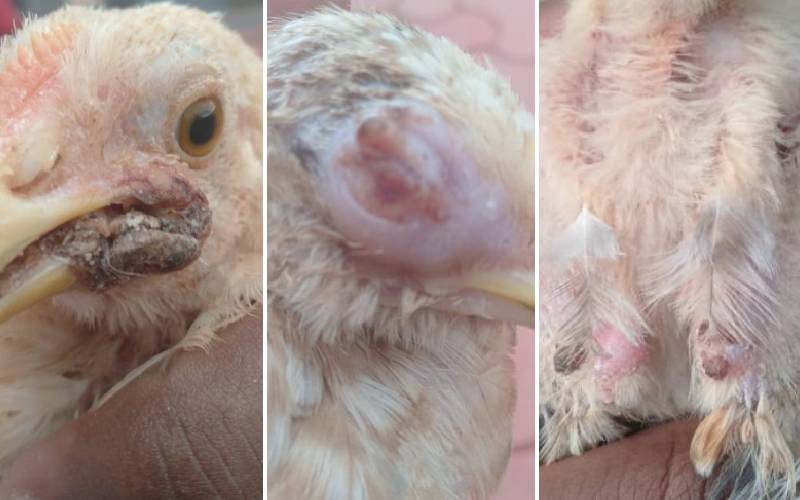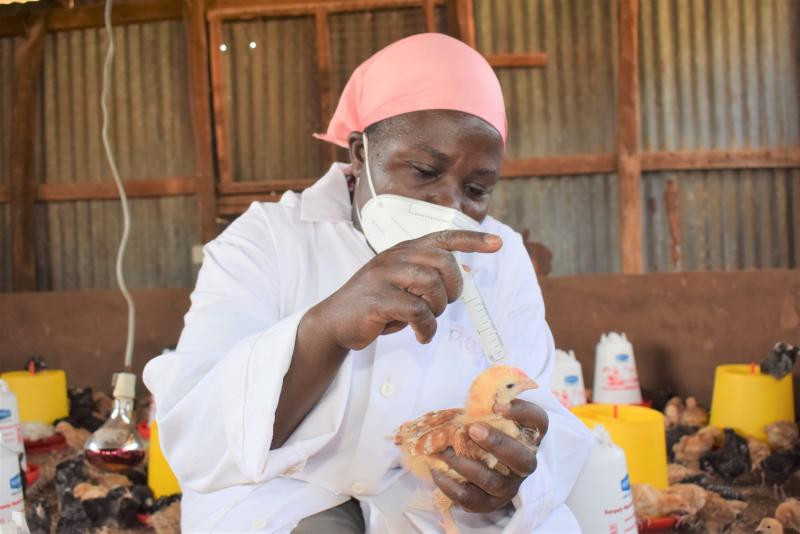How to prevent Fowl pox from affecting your flock of birds

Dennis Kigen has a flock of 148 birds of mixed ages in his farm in Kiserian. He got the stock to start his farm from this home village early last year. Last week, he started observing dark pimples on the unfeathered parts of the body of the eight-week-old chicks and yellow lesions in the mouth and blindness among the growers which are about 4 months old. He has never had his flock vaccinated. He was worried about this condition and called me.
I visited the farm last weekend. From the vaccination history and the presenting clinical signs it was clear that his flock had developed Fowl pox.
Let’s discuss this peculiar disease.
Fowl pox is a disease that occurs worldwide. All species of birds are affected. All ages are affected as well.
It is caused by Avian pox viruses which are single, linear double stranded DNA viruses. The virus comes from the same family as the viruses that cause sheep, goat and cow pox.
The effects of the disease;
Its incubation is from 4-10 days. There are two forms of the disease- cutaneous dry and diphtheritic or wet. Both may present in the same flock. The dry form is manifest as pimples or scabs on the skin (mainly on unfeathered parts of the body). The diphtheritic form shows cankers or yellow lesions in the mouth, esophagus or trachea. Other symptoms include blindness, feed refusal, lowered egg production, facial swelling.
How does this disease spread?
The disease is transmitted through mosquito bites and mechanical transmission of virus to injured skin or eye are common routes of viral spread. Wild birds are a reservoir for the viruses.
What are the presenting clinical signs?
Incubation period is from 4-10 days. They are two forms of the disease; the cutaneous or dry and the diphtheritic or wet. Both may be present in the same flock or animals.
The dry form shows as a pimple or scab on skin mainly comb, wattles, eyelids and other unfeathered portions of the body.
The wet-mucous form shows diphtheritic, cankers or yellow lesions in mouth, esophagus or trachea. Eye involvement (blindness), off feed, lower egg production, facial swelling and an increase in culls can be seen.
The disease has a high morbidity rate and a low mortality rate. This means that it spreads to many birds in the farm but very few die if any.
What are the postmortem lesions?
Cankers or false membranes in mouth (wet) are seen as slightly elevated white opaque nodules. Nodules increase in size and coalesce to yellow, cheesy, and necrotic membranes.
Grey or black papular eruptions on unfeathered portions of skin (dry). Head, face, and feet are most commonly affected, but may spread to feathered portions of the body.
How to treat & control Fowl pox?
Being a viral disease, it has no specific treatment.
However, at the advice of the attending Vet, antibiotics may be administered to counter secondary infections. The withdrawal period for eggs and meat must be observed. Administration of multivitamins help to restore immunity and hasten recovery.
What are the preventive measures?
Vaccinate chicks when they are 8 – 10 weeks by wing web puncture method. The vaccination regime against all the other poultry diseases as well as deworming should be strictly adhered to.
After administration, vaccines take at least 2 weeks to take good protective effect. Do not use antibiotics and other drugs such as dewormers together with vaccines. They may interfere with the protective effects of the vaccine.
By adopting proper vaccination regimes, you’ll save your farm from losses accruing due to loss of production, Vet fees for treatment, culling and massive deaths.
Want to get latest farming tips and videos?
Join Us
Share this article on social
 The Standard Group Plc is a multi-media organization
with investments in media platforms spanning newspaper print operations,
television, radio broadcasting, digital and online services. The Standard Group
is recognized as a leading multi-media house in Kenya with a key influence in
matters of national and international interest.
The Standard Group Plc is a multi-media organization
with investments in media platforms spanning newspaper print operations,
television, radio broadcasting, digital and online services. The Standard Group
is recognized as a leading multi-media house in Kenya with a key influence in
matters of national and international interest.
 The Standard Group Plc is a multi-media organization
with investments in media platforms spanning newspaper print operations,
television, radio broadcasting, digital and online services. The Standard Group
is recognized as a leading multi-media house in Kenya with a key influence in
matters of national and international interest.
The Standard Group Plc is a multi-media organization
with investments in media platforms spanning newspaper print operations,
television, radio broadcasting, digital and online services. The Standard Group
is recognized as a leading multi-media house in Kenya with a key influence in
matters of national and international interest.







